Critical Analysis of Meditation Intervention for Mind Body Wellness
VerifiedAdded on 2023/06/12
|10
|3859
|333
AI Summary
This essay discusses the critical analysis of meditation intervention for mind body wellness. It covers the different types of meditation techniques, their efficacy, and limitations. The essay also highlights the need for proper research methodology and clinical validity for meditation therapy.
Contribute Materials
Your contribution can guide someone’s learning journey. Share your
documents today.
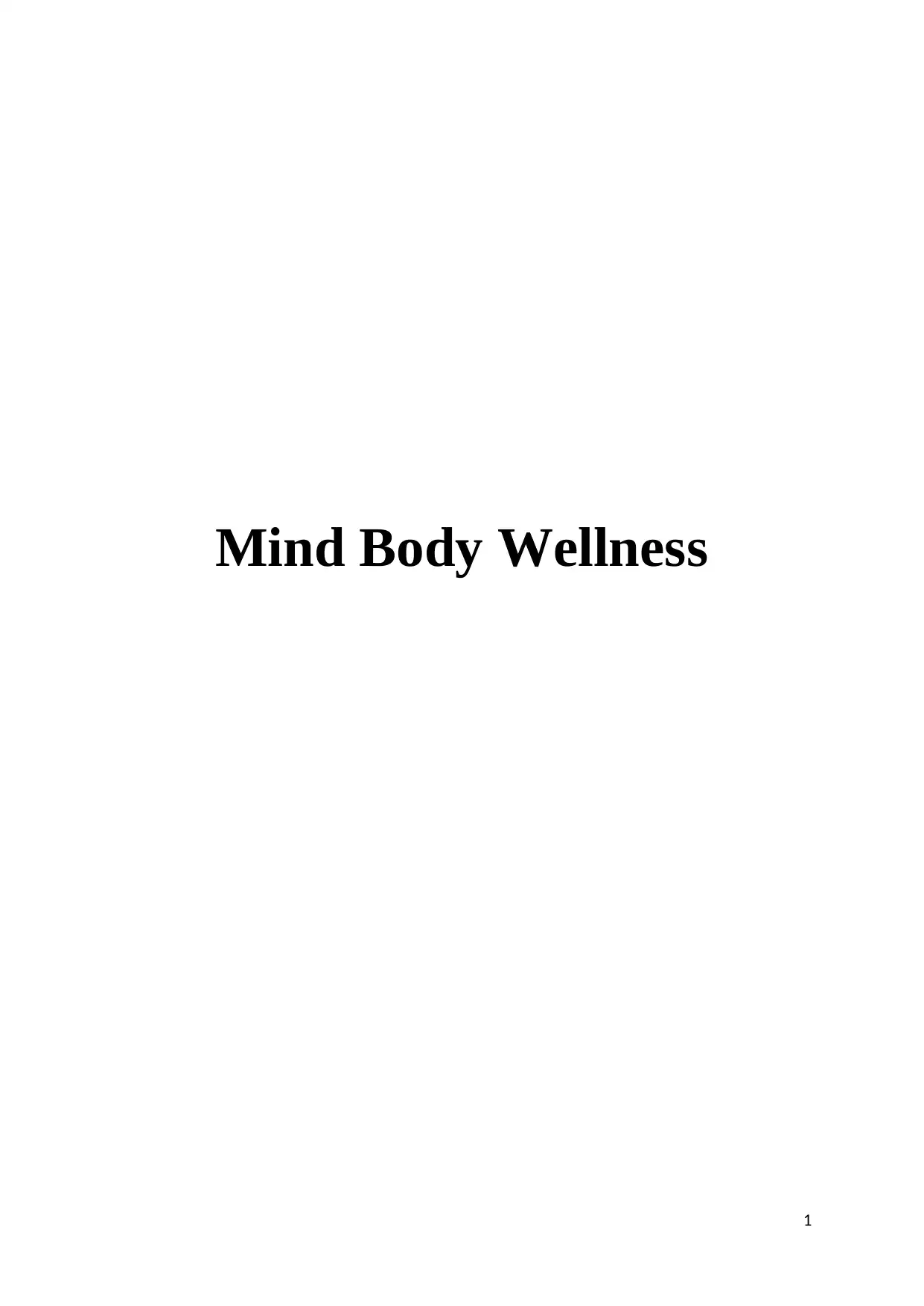
Mind Body Wellness
1
1
Secure Best Marks with AI Grader
Need help grading? Try our AI Grader for instant feedback on your assignments.
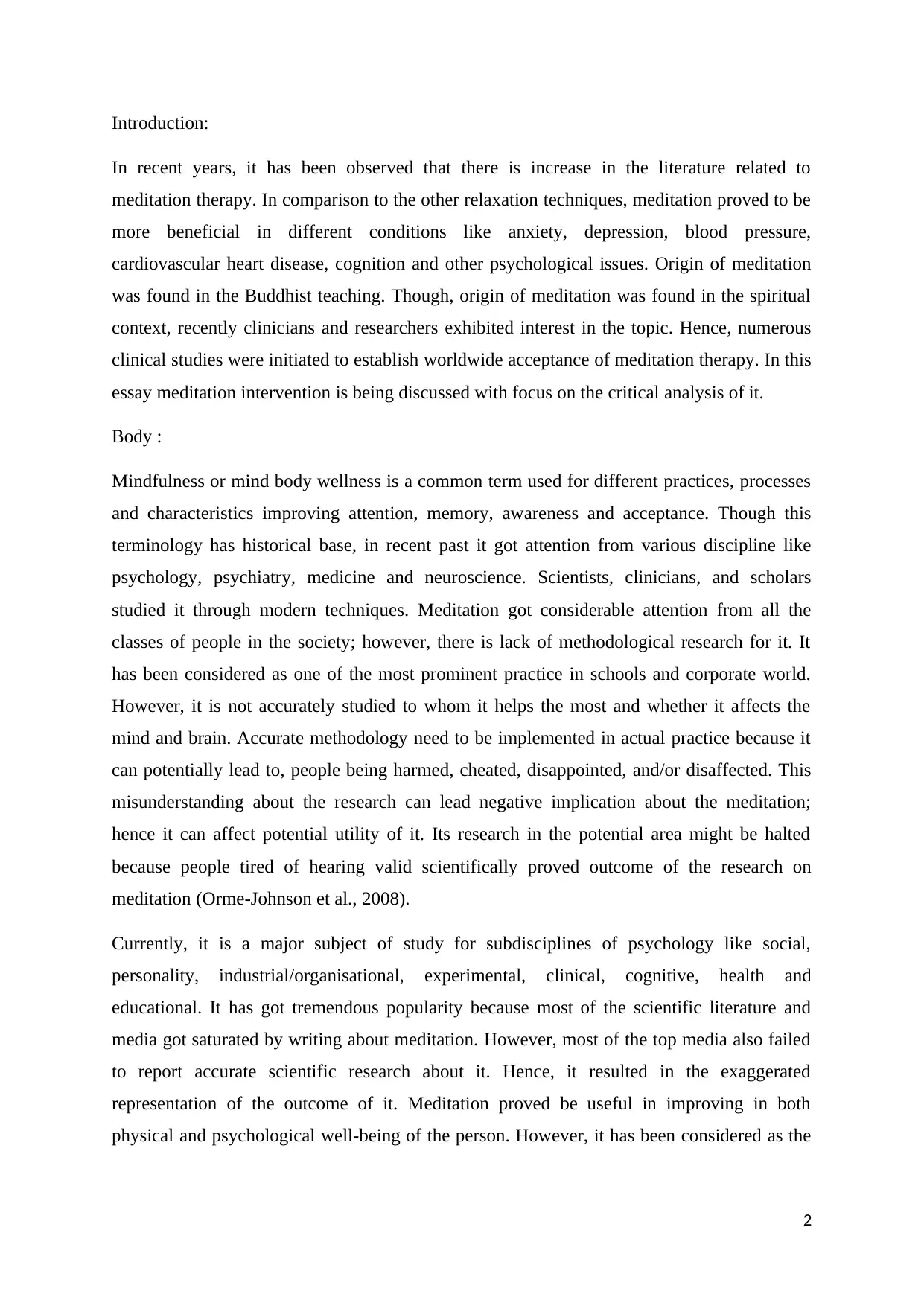
Introduction:
In recent years, it has been observed that there is increase in the literature related to
meditation therapy. In comparison to the other relaxation techniques, meditation proved to be
more beneficial in different conditions like anxiety, depression, blood pressure,
cardiovascular heart disease, cognition and other psychological issues. Origin of meditation
was found in the Buddhist teaching. Though, origin of meditation was found in the spiritual
context, recently clinicians and researchers exhibited interest in the topic. Hence, numerous
clinical studies were initiated to establish worldwide acceptance of meditation therapy. In this
essay meditation intervention is being discussed with focus on the critical analysis of it.
Body :
Mindfulness or mind body wellness is a common term used for different practices, processes
and characteristics improving attention, memory, awareness and acceptance. Though this
terminology has historical base, in recent past it got attention from various discipline like
psychology, psychiatry, medicine and neuroscience. Scientists, clinicians, and scholars
studied it through modern techniques. Meditation got considerable attention from all the
classes of people in the society; however, there is lack of methodological research for it. It
has been considered as one of the most prominent practice in schools and corporate world.
However, it is not accurately studied to whom it helps the most and whether it affects the
mind and brain. Accurate methodology need to be implemented in actual practice because it
can potentially lead to, people being harmed, cheated, disappointed, and/or disaffected. This
misunderstanding about the research can lead negative implication about the meditation;
hence it can affect potential utility of it. Its research in the potential area might be halted
because people tired of hearing valid scientifically proved outcome of the research on
meditation (Orme-Johnson et al., 2008).
Currently, it is a major subject of study for subdisciplines of psychology like social,
personality, industrial/organisational, experimental, clinical, cognitive, health and
educational. It has got tremendous popularity because most of the scientific literature and
media got saturated by writing about meditation. However, most of the top media also failed
to report accurate scientific research about it. Hence, it resulted in the exaggerated
representation of the outcome of it. Meditation proved be useful in improving in both
physical and psychological well-being of the person. However, it has been considered as the
2
In recent years, it has been observed that there is increase in the literature related to
meditation therapy. In comparison to the other relaxation techniques, meditation proved to be
more beneficial in different conditions like anxiety, depression, blood pressure,
cardiovascular heart disease, cognition and other psychological issues. Origin of meditation
was found in the Buddhist teaching. Though, origin of meditation was found in the spiritual
context, recently clinicians and researchers exhibited interest in the topic. Hence, numerous
clinical studies were initiated to establish worldwide acceptance of meditation therapy. In this
essay meditation intervention is being discussed with focus on the critical analysis of it.
Body :
Mindfulness or mind body wellness is a common term used for different practices, processes
and characteristics improving attention, memory, awareness and acceptance. Though this
terminology has historical base, in recent past it got attention from various discipline like
psychology, psychiatry, medicine and neuroscience. Scientists, clinicians, and scholars
studied it through modern techniques. Meditation got considerable attention from all the
classes of people in the society; however, there is lack of methodological research for it. It
has been considered as one of the most prominent practice in schools and corporate world.
However, it is not accurately studied to whom it helps the most and whether it affects the
mind and brain. Accurate methodology need to be implemented in actual practice because it
can potentially lead to, people being harmed, cheated, disappointed, and/or disaffected. This
misunderstanding about the research can lead negative implication about the meditation;
hence it can affect potential utility of it. Its research in the potential area might be halted
because people tired of hearing valid scientifically proved outcome of the research on
meditation (Orme-Johnson et al., 2008).
Currently, it is a major subject of study for subdisciplines of psychology like social,
personality, industrial/organisational, experimental, clinical, cognitive, health and
educational. It has got tremendous popularity because most of the scientific literature and
media got saturated by writing about meditation. However, most of the top media also failed
to report accurate scientific research about it. Hence, it resulted in the exaggerated
representation of the outcome of it. Meditation proved be useful in improving in both
physical and psychological well-being of the person. However, it has been considered as the
2

universal solution for most of the human deficiencies and ailments (Godfrin and van
Heeringen. 2010).
Empirical results need to be properly validated based on the type of meditation. Meditation
for five minutes and meditation for 3 months are both being considered as mindfulness.
Hence, there should be clear distinction between these two types of meditation practices. It
can be resolved by establishing significant relationship between the clinical and practical
outcome. It can be helpful in communicating accurate scientific aspects to the general public.
Proper definition need to be established for meditation (Barker, 2014).
There are numerous studies are available for the effects of meditation on the concentrative
and mindfulness-based techniques. Physical relaxation can be achieved through stress
management effects of meditation. However, it has been found that there is robust correlation
between meditation and cognitive-attentional processes. Understanding of these processes
like physical relaxation and cognitive-attentional processes can be helpful in understanding
different stages at the time of actual practice of meditation (Manicavasgar et al., 2012).
Mindfulness meditation can be helpful in the moment-to-moment and non-judgemental
awareness of self’s existing experience. It has not been proved whether this awareness is
narrow or broad. Mindfulness meditation can be helpful in firm awareness of self’s internal
and external experience. Internal experience includes cognitive-affective-sensory awareness
and external experience include social-environmental awareness. Hence, it can be argued that
meditation can be helpful in creating stable attention and unbiased awareness. It can produce
different effects like physical relaxation, emotional balance and behavioural regulation.
However, meditation is not being used widely for social and environmental awareness. All
the changes in occurring during meditation can lead to stress management. There is less
evidence available for the effects of meditation on physical and physiological processes
(Ratanasiripong, 2015).
There are varied meditation techniques are available like Mindfulness Based Stress
Reduction (MBSR) and Mindfulness Based Cognitive Therapy (MBCT)), or broad categories
of meditation or mindfulness techniques, such as focused attention and open monitoring, or
with and without movement (MacCoon et al., 2012). All these techniques provide small to
moderate improvement in the depression and anxiety including in patients with other
comorbid conditions. It is difficult to identify efficacious component of the meditation
therapy because most of the studies demonstrated confounding results due to following
reasons : there is no detailed comparison is available for the praxis elements of each
3
Heeringen. 2010).
Empirical results need to be properly validated based on the type of meditation. Meditation
for five minutes and meditation for 3 months are both being considered as mindfulness.
Hence, there should be clear distinction between these two types of meditation practices. It
can be resolved by establishing significant relationship between the clinical and practical
outcome. It can be helpful in communicating accurate scientific aspects to the general public.
Proper definition need to be established for meditation (Barker, 2014).
There are numerous studies are available for the effects of meditation on the concentrative
and mindfulness-based techniques. Physical relaxation can be achieved through stress
management effects of meditation. However, it has been found that there is robust correlation
between meditation and cognitive-attentional processes. Understanding of these processes
like physical relaxation and cognitive-attentional processes can be helpful in understanding
different stages at the time of actual practice of meditation (Manicavasgar et al., 2012).
Mindfulness meditation can be helpful in the moment-to-moment and non-judgemental
awareness of self’s existing experience. It has not been proved whether this awareness is
narrow or broad. Mindfulness meditation can be helpful in firm awareness of self’s internal
and external experience. Internal experience includes cognitive-affective-sensory awareness
and external experience include social-environmental awareness. Hence, it can be argued that
meditation can be helpful in creating stable attention and unbiased awareness. It can produce
different effects like physical relaxation, emotional balance and behavioural regulation.
However, meditation is not being used widely for social and environmental awareness. All
the changes in occurring during meditation can lead to stress management. There is less
evidence available for the effects of meditation on physical and physiological processes
(Ratanasiripong, 2015).
There are varied meditation techniques are available like Mindfulness Based Stress
Reduction (MBSR) and Mindfulness Based Cognitive Therapy (MBCT)), or broad categories
of meditation or mindfulness techniques, such as focused attention and open monitoring, or
with and without movement (MacCoon et al., 2012). All these techniques provide small to
moderate improvement in the depression and anxiety including in patients with other
comorbid conditions. It is difficult to identify efficacious component of the meditation
therapy because most of the studies demonstrated confounding results due to following
reasons : there is no detailed comparison is available for the praxis elements of each
3
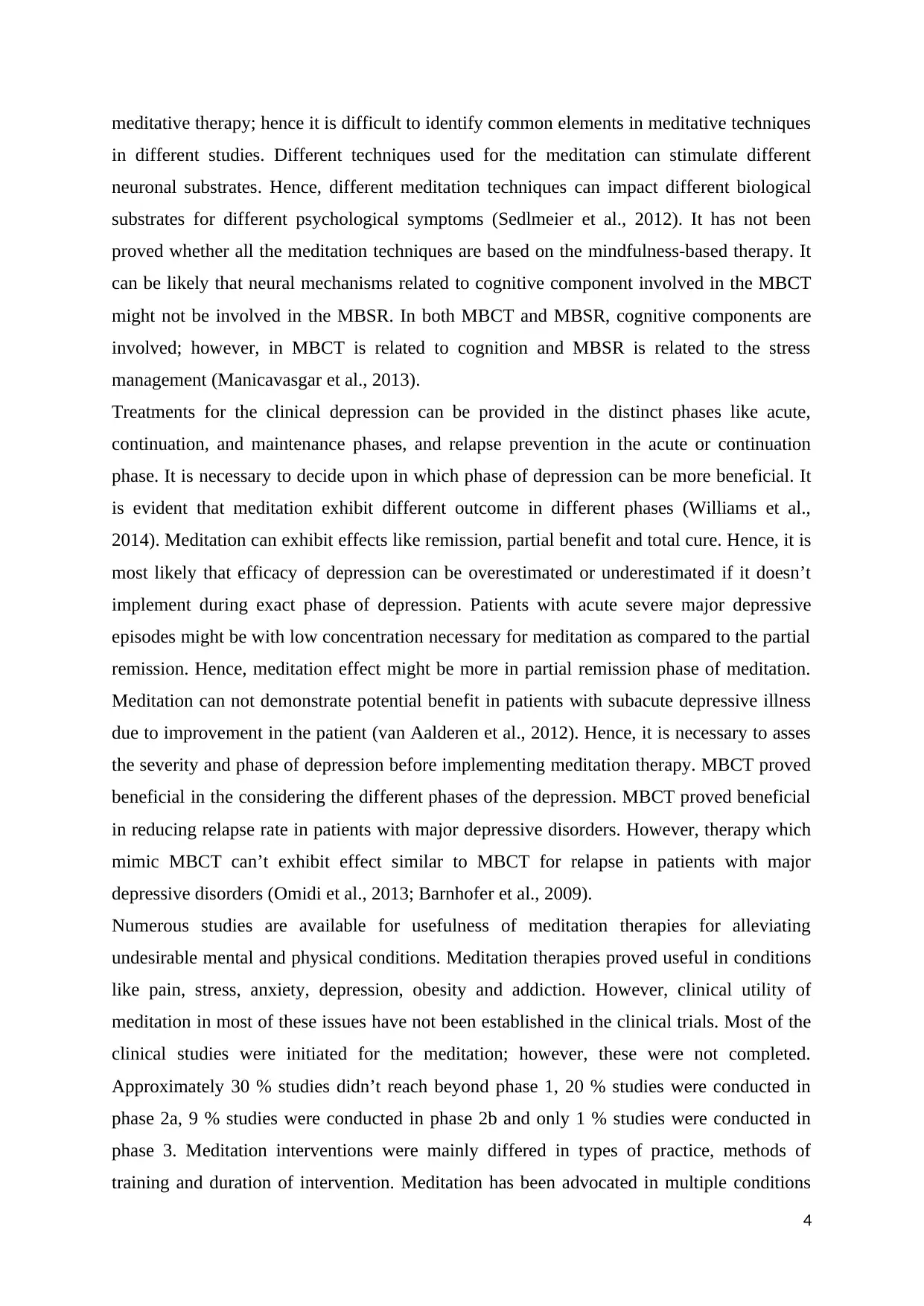
meditative therapy; hence it is difficult to identify common elements in meditative techniques
in different studies. Different techniques used for the meditation can stimulate different
neuronal substrates. Hence, different meditation techniques can impact different biological
substrates for different psychological symptoms (Sedlmeier et al., 2012). It has not been
proved whether all the meditation techniques are based on the mindfulness-based therapy. It
can be likely that neural mechanisms related to cognitive component involved in the MBCT
might not be involved in the MBSR. In both MBCT and MBSR, cognitive components are
involved; however, in MBCT is related to cognition and MBSR is related to the stress
management (Manicavasgar et al., 2013).
Treatments for the clinical depression can be provided in the distinct phases like acute,
continuation, and maintenance phases, and relapse prevention in the acute or continuation
phase. It is necessary to decide upon in which phase of depression can be more beneficial. It
is evident that meditation exhibit different outcome in different phases (Williams et al.,
2014). Meditation can exhibit effects like remission, partial benefit and total cure. Hence, it is
most likely that efficacy of depression can be overestimated or underestimated if it doesn’t
implement during exact phase of depression. Patients with acute severe major depressive
episodes might be with low concentration necessary for meditation as compared to the partial
remission. Hence, meditation effect might be more in partial remission phase of meditation.
Meditation can not demonstrate potential benefit in patients with subacute depressive illness
due to improvement in the patient (van Aalderen et al., 2012). Hence, it is necessary to asses
the severity and phase of depression before implementing meditation therapy. MBCT proved
beneficial in the considering the different phases of the depression. MBCT proved beneficial
in reducing relapse rate in patients with major depressive disorders. However, therapy which
mimic MBCT can’t exhibit effect similar to MBCT for relapse in patients with major
depressive disorders (Omidi et al., 2013; Barnhofer et al., 2009).
Numerous studies are available for usefulness of meditation therapies for alleviating
undesirable mental and physical conditions. Meditation therapies proved useful in conditions
like pain, stress, anxiety, depression, obesity and addiction. However, clinical utility of
meditation in most of these issues have not been established in the clinical trials. Most of the
clinical studies were initiated for the meditation; however, these were not completed.
Approximately 30 % studies didn’t reach beyond phase 1, 20 % studies were conducted in
phase 2a, 9 % studies were conducted in phase 2b and only 1 % studies were conducted in
phase 3. Meditation interventions were mainly differed in types of practice, methods of
training and duration of intervention. Meditation has been advocated in multiple conditions
4
in different studies. Different techniques used for the meditation can stimulate different
neuronal substrates. Hence, different meditation techniques can impact different biological
substrates for different psychological symptoms (Sedlmeier et al., 2012). It has not been
proved whether all the meditation techniques are based on the mindfulness-based therapy. It
can be likely that neural mechanisms related to cognitive component involved in the MBCT
might not be involved in the MBSR. In both MBCT and MBSR, cognitive components are
involved; however, in MBCT is related to cognition and MBSR is related to the stress
management (Manicavasgar et al., 2013).
Treatments for the clinical depression can be provided in the distinct phases like acute,
continuation, and maintenance phases, and relapse prevention in the acute or continuation
phase. It is necessary to decide upon in which phase of depression can be more beneficial. It
is evident that meditation exhibit different outcome in different phases (Williams et al.,
2014). Meditation can exhibit effects like remission, partial benefit and total cure. Hence, it is
most likely that efficacy of depression can be overestimated or underestimated if it doesn’t
implement during exact phase of depression. Patients with acute severe major depressive
episodes might be with low concentration necessary for meditation as compared to the partial
remission. Hence, meditation effect might be more in partial remission phase of meditation.
Meditation can not demonstrate potential benefit in patients with subacute depressive illness
due to improvement in the patient (van Aalderen et al., 2012). Hence, it is necessary to asses
the severity and phase of depression before implementing meditation therapy. MBCT proved
beneficial in the considering the different phases of the depression. MBCT proved beneficial
in reducing relapse rate in patients with major depressive disorders. However, therapy which
mimic MBCT can’t exhibit effect similar to MBCT for relapse in patients with major
depressive disorders (Omidi et al., 2013; Barnhofer et al., 2009).
Numerous studies are available for usefulness of meditation therapies for alleviating
undesirable mental and physical conditions. Meditation therapies proved useful in conditions
like pain, stress, anxiety, depression, obesity and addiction. However, clinical utility of
meditation in most of these issues have not been established in the clinical trials. Most of the
clinical studies were initiated for the meditation; however, these were not completed.
Approximately 30 % studies didn’t reach beyond phase 1, 20 % studies were conducted in
phase 2a, 9 % studies were conducted in phase 2b and only 1 % studies were conducted in
phase 3. Meditation interventions were mainly differed in types of practice, methods of
training and duration of intervention. Meditation has been advocated in multiple conditions
4
Secure Best Marks with AI Grader
Need help grading? Try our AI Grader for instant feedback on your assignments.
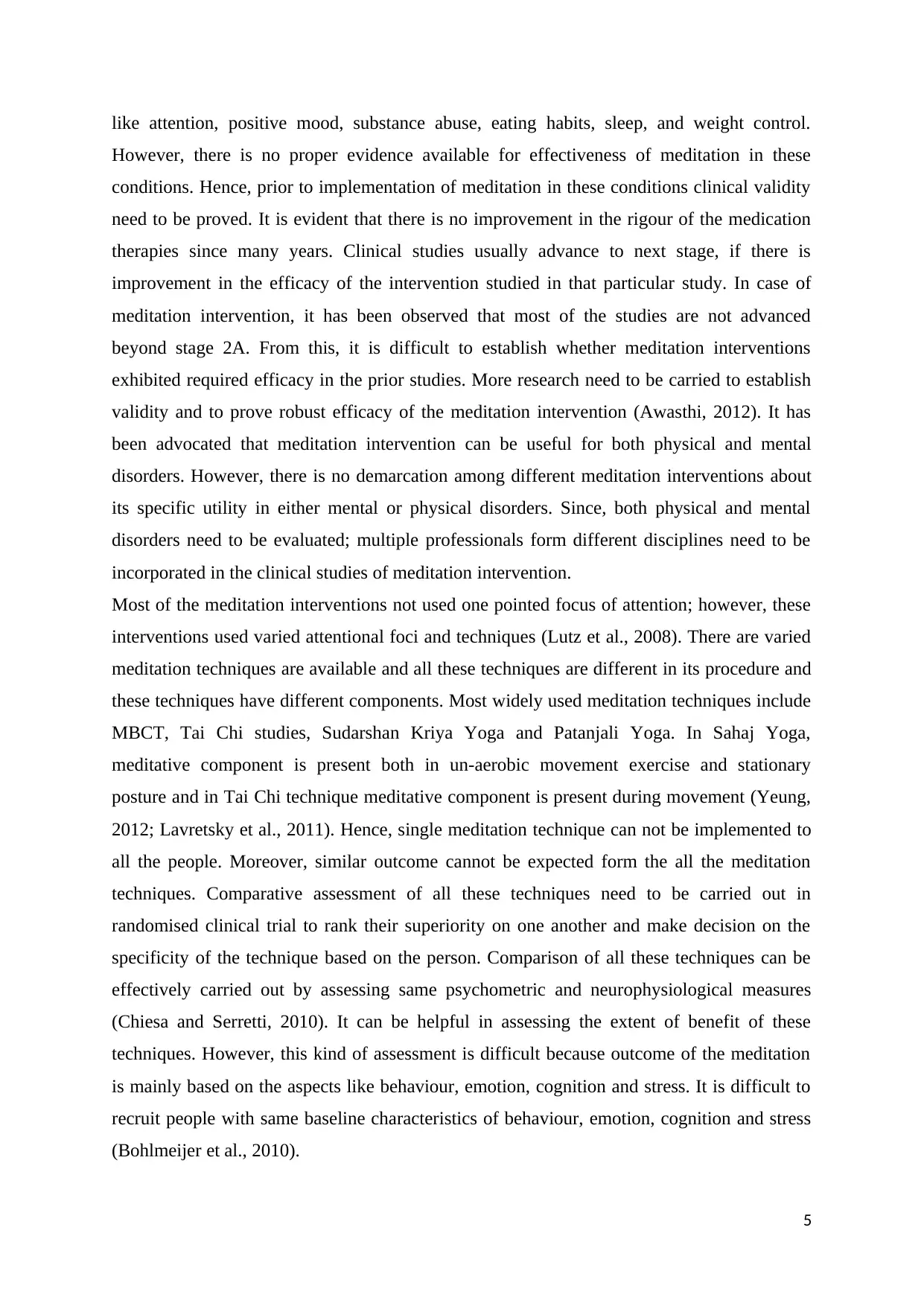
like attention, positive mood, substance abuse, eating habits, sleep, and weight control.
However, there is no proper evidence available for effectiveness of meditation in these
conditions. Hence, prior to implementation of meditation in these conditions clinical validity
need to be proved. It is evident that there is no improvement in the rigour of the medication
therapies since many years. Clinical studies usually advance to next stage, if there is
improvement in the efficacy of the intervention studied in that particular study. In case of
meditation intervention, it has been observed that most of the studies are not advanced
beyond stage 2A. From this, it is difficult to establish whether meditation interventions
exhibited required efficacy in the prior studies. More research need to be carried to establish
validity and to prove robust efficacy of the meditation intervention (Awasthi, 2012). It has
been advocated that meditation intervention can be useful for both physical and mental
disorders. However, there is no demarcation among different meditation interventions about
its specific utility in either mental or physical disorders. Since, both physical and mental
disorders need to be evaluated; multiple professionals form different disciplines need to be
incorporated in the clinical studies of meditation intervention.
Most of the meditation interventions not used one pointed focus of attention; however, these
interventions used varied attentional foci and techniques (Lutz et al., 2008). There are varied
meditation techniques are available and all these techniques are different in its procedure and
these techniques have different components. Most widely used meditation techniques include
MBCT, Tai Chi studies, Sudarshan Kriya Yoga and Patanjali Yoga. In Sahaj Yoga,
meditative component is present both in un-aerobic movement exercise and stationary
posture and in Tai Chi technique meditative component is present during movement (Yeung,
2012; Lavretsky et al., 2011). Hence, single meditation technique can not be implemented to
all the people. Moreover, similar outcome cannot be expected form the all the meditation
techniques. Comparative assessment of all these techniques need to be carried out in
randomised clinical trial to rank their superiority on one another and make decision on the
specificity of the technique based on the person. Comparison of all these techniques can be
effectively carried out by assessing same psychometric and neurophysiological measures
(Chiesa and Serretti, 2010). It can be helpful in assessing the extent of benefit of these
techniques. However, this kind of assessment is difficult because outcome of the meditation
is mainly based on the aspects like behaviour, emotion, cognition and stress. It is difficult to
recruit people with same baseline characteristics of behaviour, emotion, cognition and stress
(Bohlmeijer et al., 2010).
5
However, there is no proper evidence available for effectiveness of meditation in these
conditions. Hence, prior to implementation of meditation in these conditions clinical validity
need to be proved. It is evident that there is no improvement in the rigour of the medication
therapies since many years. Clinical studies usually advance to next stage, if there is
improvement in the efficacy of the intervention studied in that particular study. In case of
meditation intervention, it has been observed that most of the studies are not advanced
beyond stage 2A. From this, it is difficult to establish whether meditation interventions
exhibited required efficacy in the prior studies. More research need to be carried to establish
validity and to prove robust efficacy of the meditation intervention (Awasthi, 2012). It has
been advocated that meditation intervention can be useful for both physical and mental
disorders. However, there is no demarcation among different meditation interventions about
its specific utility in either mental or physical disorders. Since, both physical and mental
disorders need to be evaluated; multiple professionals form different disciplines need to be
incorporated in the clinical studies of meditation intervention.
Most of the meditation interventions not used one pointed focus of attention; however, these
interventions used varied attentional foci and techniques (Lutz et al., 2008). There are varied
meditation techniques are available and all these techniques are different in its procedure and
these techniques have different components. Most widely used meditation techniques include
MBCT, Tai Chi studies, Sudarshan Kriya Yoga and Patanjali Yoga. In Sahaj Yoga,
meditative component is present both in un-aerobic movement exercise and stationary
posture and in Tai Chi technique meditative component is present during movement (Yeung,
2012; Lavretsky et al., 2011). Hence, single meditation technique can not be implemented to
all the people. Moreover, similar outcome cannot be expected form the all the meditation
techniques. Comparative assessment of all these techniques need to be carried out in
randomised clinical trial to rank their superiority on one another and make decision on the
specificity of the technique based on the person. Comparison of all these techniques can be
effectively carried out by assessing same psychometric and neurophysiological measures
(Chiesa and Serretti, 2010). It can be helpful in assessing the extent of benefit of these
techniques. However, this kind of assessment is difficult because outcome of the meditation
is mainly based on the aspects like behaviour, emotion, cognition and stress. It is difficult to
recruit people with same baseline characteristics of behaviour, emotion, cognition and stress
(Bohlmeijer et al., 2010).
5
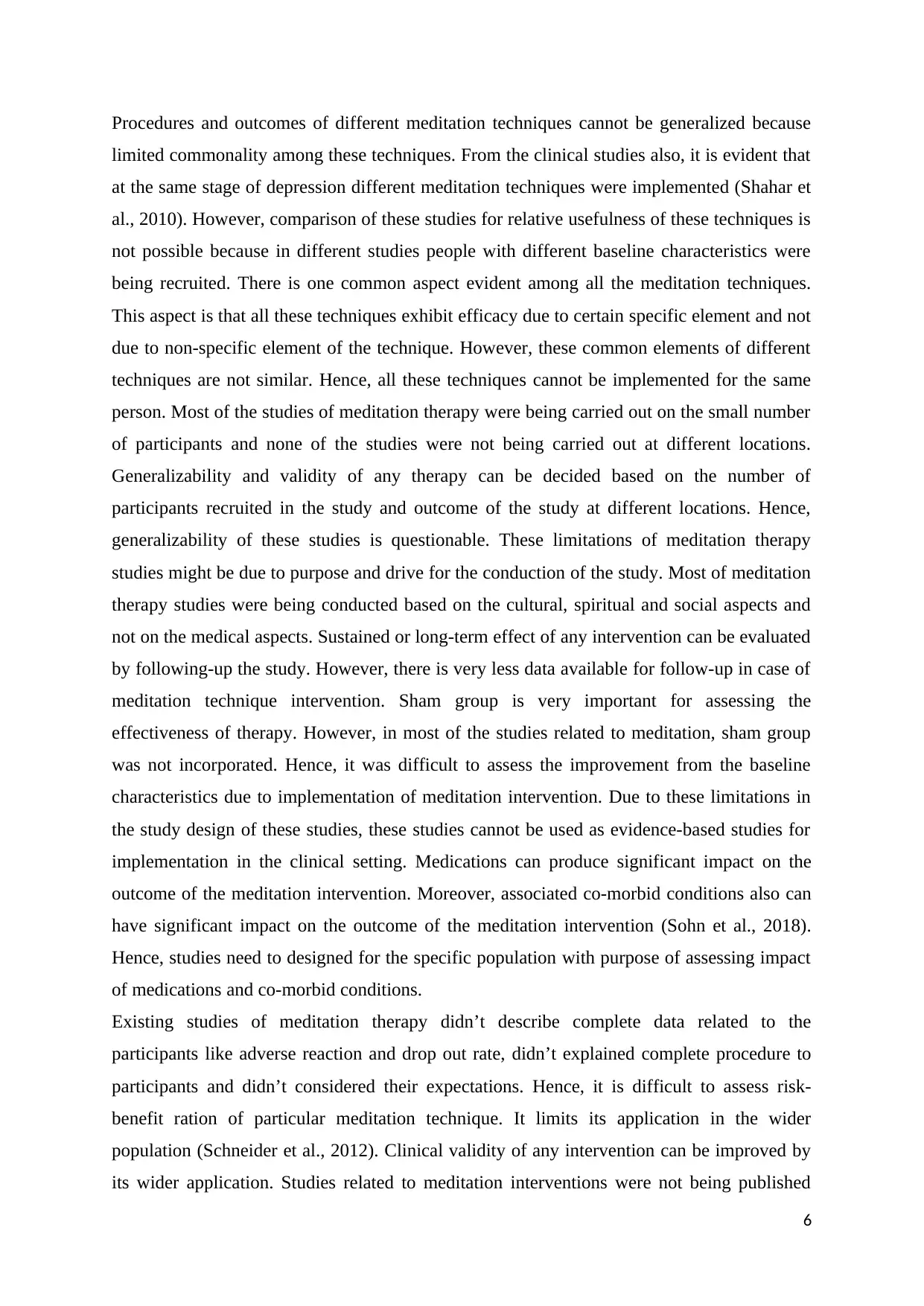
Procedures and outcomes of different meditation techniques cannot be generalized because
limited commonality among these techniques. From the clinical studies also, it is evident that
at the same stage of depression different meditation techniques were implemented (Shahar et
al., 2010). However, comparison of these studies for relative usefulness of these techniques is
not possible because in different studies people with different baseline characteristics were
being recruited. There is one common aspect evident among all the meditation techniques.
This aspect is that all these techniques exhibit efficacy due to certain specific element and not
due to non-specific element of the technique. However, these common elements of different
techniques are not similar. Hence, all these techniques cannot be implemented for the same
person. Most of the studies of meditation therapy were being carried out on the small number
of participants and none of the studies were not being carried out at different locations.
Generalizability and validity of any therapy can be decided based on the number of
participants recruited in the study and outcome of the study at different locations. Hence,
generalizability of these studies is questionable. These limitations of meditation therapy
studies might be due to purpose and drive for the conduction of the study. Most of meditation
therapy studies were being conducted based on the cultural, spiritual and social aspects and
not on the medical aspects. Sustained or long-term effect of any intervention can be evaluated
by following-up the study. However, there is very less data available for follow-up in case of
meditation technique intervention. Sham group is very important for assessing the
effectiveness of therapy. However, in most of the studies related to meditation, sham group
was not incorporated. Hence, it was difficult to assess the improvement from the baseline
characteristics due to implementation of meditation intervention. Due to these limitations in
the study design of these studies, these studies cannot be used as evidence-based studies for
implementation in the clinical setting. Medications can produce significant impact on the
outcome of the meditation intervention. Moreover, associated co-morbid conditions also can
have significant impact on the outcome of the meditation intervention (Sohn et al., 2018).
Hence, studies need to designed for the specific population with purpose of assessing impact
of medications and co-morbid conditions.
Existing studies of meditation therapy didn’t describe complete data related to the
participants like adverse reaction and drop out rate, didn’t explained complete procedure to
participants and didn’t considered their expectations. Hence, it is difficult to assess risk-
benefit ration of particular meditation technique. It limits its application in the wider
population (Schneider et al., 2012). Clinical validity of any intervention can be improved by
its wider application. Studies related to meditation interventions were not being published
6
limited commonality among these techniques. From the clinical studies also, it is evident that
at the same stage of depression different meditation techniques were implemented (Shahar et
al., 2010). However, comparison of these studies for relative usefulness of these techniques is
not possible because in different studies people with different baseline characteristics were
being recruited. There is one common aspect evident among all the meditation techniques.
This aspect is that all these techniques exhibit efficacy due to certain specific element and not
due to non-specific element of the technique. However, these common elements of different
techniques are not similar. Hence, all these techniques cannot be implemented for the same
person. Most of the studies of meditation therapy were being carried out on the small number
of participants and none of the studies were not being carried out at different locations.
Generalizability and validity of any therapy can be decided based on the number of
participants recruited in the study and outcome of the study at different locations. Hence,
generalizability of these studies is questionable. These limitations of meditation therapy
studies might be due to purpose and drive for the conduction of the study. Most of meditation
therapy studies were being conducted based on the cultural, spiritual and social aspects and
not on the medical aspects. Sustained or long-term effect of any intervention can be evaluated
by following-up the study. However, there is very less data available for follow-up in case of
meditation technique intervention. Sham group is very important for assessing the
effectiveness of therapy. However, in most of the studies related to meditation, sham group
was not incorporated. Hence, it was difficult to assess the improvement from the baseline
characteristics due to implementation of meditation intervention. Due to these limitations in
the study design of these studies, these studies cannot be used as evidence-based studies for
implementation in the clinical setting. Medications can produce significant impact on the
outcome of the meditation intervention. Moreover, associated co-morbid conditions also can
have significant impact on the outcome of the meditation intervention (Sohn et al., 2018).
Hence, studies need to designed for the specific population with purpose of assessing impact
of medications and co-morbid conditions.
Existing studies of meditation therapy didn’t describe complete data related to the
participants like adverse reaction and drop out rate, didn’t explained complete procedure to
participants and didn’t considered their expectations. Hence, it is difficult to assess risk-
benefit ration of particular meditation technique. It limits its application in the wider
population (Schneider et al., 2012). Clinical validity of any intervention can be improved by
its wider application. Studies related to meditation interventions were not being published
6
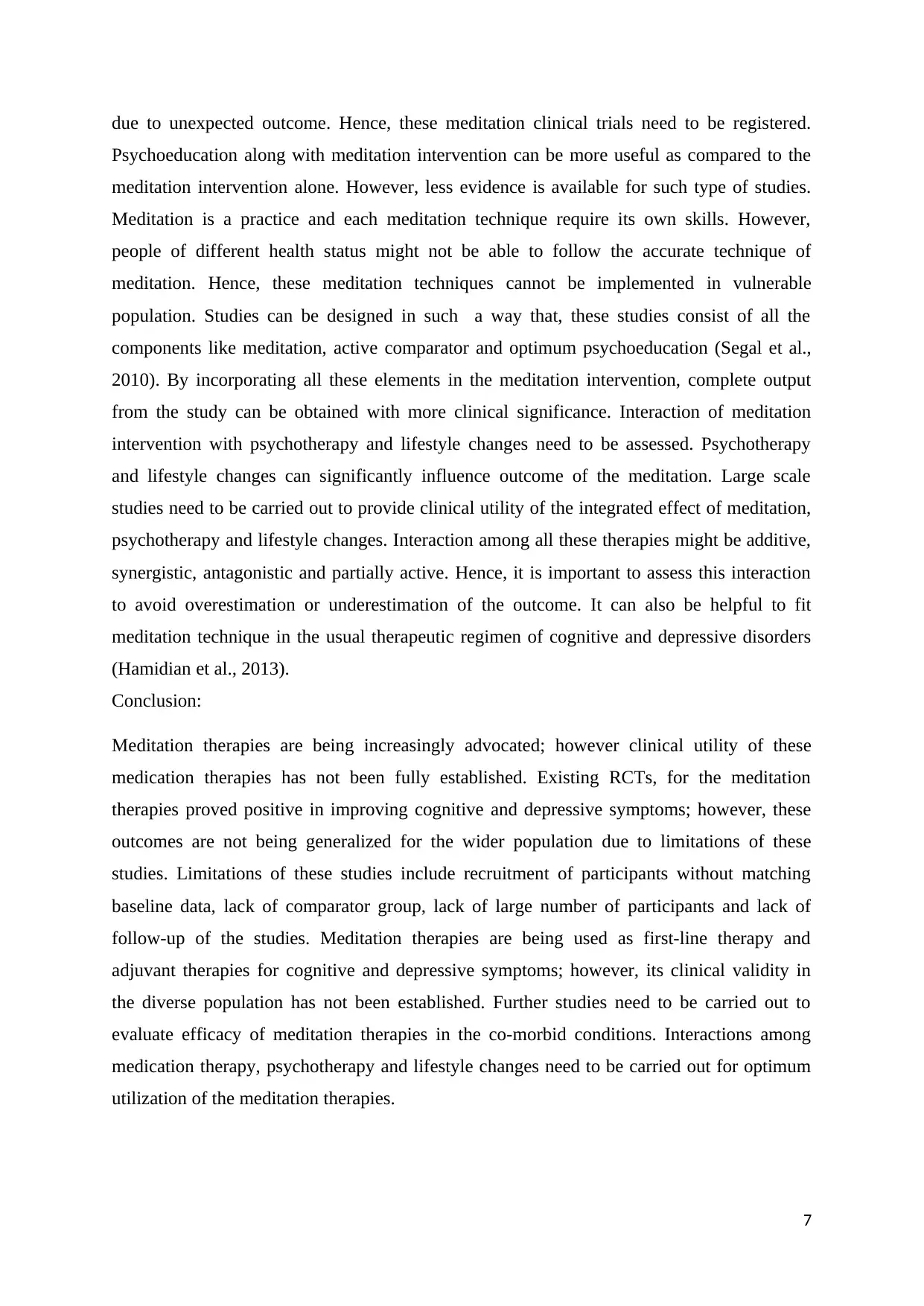
due to unexpected outcome. Hence, these meditation clinical trials need to be registered.
Psychoeducation along with meditation intervention can be more useful as compared to the
meditation intervention alone. However, less evidence is available for such type of studies.
Meditation is a practice and each meditation technique require its own skills. However,
people of different health status might not be able to follow the accurate technique of
meditation. Hence, these meditation techniques cannot be implemented in vulnerable
population. Studies can be designed in such a way that, these studies consist of all the
components like meditation, active comparator and optimum psychoeducation (Segal et al.,
2010). By incorporating all these elements in the meditation intervention, complete output
from the study can be obtained with more clinical significance. Interaction of meditation
intervention with psychotherapy and lifestyle changes need to be assessed. Psychotherapy
and lifestyle changes can significantly influence outcome of the meditation. Large scale
studies need to be carried out to provide clinical utility of the integrated effect of meditation,
psychotherapy and lifestyle changes. Interaction among all these therapies might be additive,
synergistic, antagonistic and partially active. Hence, it is important to assess this interaction
to avoid overestimation or underestimation of the outcome. It can also be helpful to fit
meditation technique in the usual therapeutic regimen of cognitive and depressive disorders
(Hamidian et al., 2013).
Conclusion:
Meditation therapies are being increasingly advocated; however clinical utility of these
medication therapies has not been fully established. Existing RCTs, for the meditation
therapies proved positive in improving cognitive and depressive symptoms; however, these
outcomes are not being generalized for the wider population due to limitations of these
studies. Limitations of these studies include recruitment of participants without matching
baseline data, lack of comparator group, lack of large number of participants and lack of
follow-up of the studies. Meditation therapies are being used as first-line therapy and
adjuvant therapies for cognitive and depressive symptoms; however, its clinical validity in
the diverse population has not been established. Further studies need to be carried out to
evaluate efficacy of meditation therapies in the co-morbid conditions. Interactions among
medication therapy, psychotherapy and lifestyle changes need to be carried out for optimum
utilization of the meditation therapies.
7
Psychoeducation along with meditation intervention can be more useful as compared to the
meditation intervention alone. However, less evidence is available for such type of studies.
Meditation is a practice and each meditation technique require its own skills. However,
people of different health status might not be able to follow the accurate technique of
meditation. Hence, these meditation techniques cannot be implemented in vulnerable
population. Studies can be designed in such a way that, these studies consist of all the
components like meditation, active comparator and optimum psychoeducation (Segal et al.,
2010). By incorporating all these elements in the meditation intervention, complete output
from the study can be obtained with more clinical significance. Interaction of meditation
intervention with psychotherapy and lifestyle changes need to be assessed. Psychotherapy
and lifestyle changes can significantly influence outcome of the meditation. Large scale
studies need to be carried out to provide clinical utility of the integrated effect of meditation,
psychotherapy and lifestyle changes. Interaction among all these therapies might be additive,
synergistic, antagonistic and partially active. Hence, it is important to assess this interaction
to avoid overestimation or underestimation of the outcome. It can also be helpful to fit
meditation technique in the usual therapeutic regimen of cognitive and depressive disorders
(Hamidian et al., 2013).
Conclusion:
Meditation therapies are being increasingly advocated; however clinical utility of these
medication therapies has not been fully established. Existing RCTs, for the meditation
therapies proved positive in improving cognitive and depressive symptoms; however, these
outcomes are not being generalized for the wider population due to limitations of these
studies. Limitations of these studies include recruitment of participants without matching
baseline data, lack of comparator group, lack of large number of participants and lack of
follow-up of the studies. Meditation therapies are being used as first-line therapy and
adjuvant therapies for cognitive and depressive symptoms; however, its clinical validity in
the diverse population has not been established. Further studies need to be carried out to
evaluate efficacy of meditation therapies in the co-morbid conditions. Interactions among
medication therapy, psychotherapy and lifestyle changes need to be carried out for optimum
utilization of the meditation therapies.
7
Paraphrase This Document
Need a fresh take? Get an instant paraphrase of this document with our AI Paraphraser
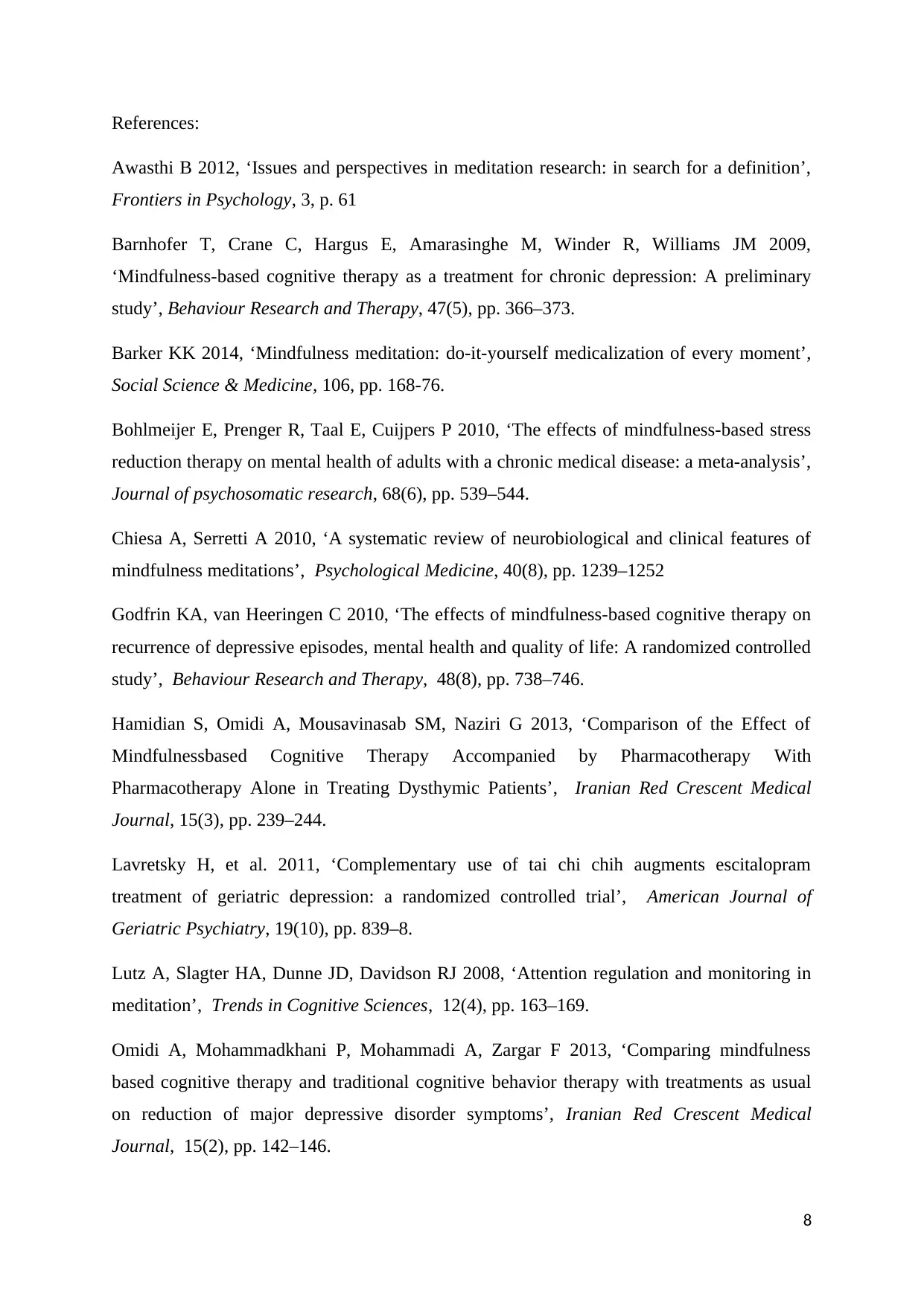
References:
Awasthi B 2012, ‘Issues and perspectives in meditation research: in search for a definition’,
Frontiers in Psychology, 3, p. 61
Barnhofer T, Crane C, Hargus E, Amarasinghe M, Winder R, Williams JM 2009,
‘Mindfulness-based cognitive therapy as a treatment for chronic depression: A preliminary
study’, Behaviour Research and Therapy, 47(5), pp. 366–373.
Barker KK 2014, ‘Mindfulness meditation: do-it-yourself medicalization of every moment’,
Social Science & Medicine, 106, pp. 168-76.
Bohlmeijer E, Prenger R, Taal E, Cuijpers P 2010, ‘The effects of mindfulness-based stress
reduction therapy on mental health of adults with a chronic medical disease: a meta-analysis’,
Journal of psychosomatic research, 68(6), pp. 539–544.
Chiesa A, Serretti A 2010, ‘A systematic review of neurobiological and clinical features of
mindfulness meditations’, Psychological Medicine, 40(8), pp. 1239–1252
Godfrin KA, van Heeringen C 2010, ‘The effects of mindfulness-based cognitive therapy on
recurrence of depressive episodes, mental health and quality of life: A randomized controlled
study’, Behaviour Research and Therapy, 48(8), pp. 738–746.
Hamidian S, Omidi A, Mousavinasab SM, Naziri G 2013, ‘Comparison of the Effect of
Mindfulnessbased Cognitive Therapy Accompanied by Pharmacotherapy With
Pharmacotherapy Alone in Treating Dysthymic Patients’, Iranian Red Crescent Medical
Journal, 15(3), pp. 239–244.
Lavretsky H, et al. 2011, ‘Complementary use of tai chi chih augments escitalopram
treatment of geriatric depression: a randomized controlled trial’, American Journal of
Geriatric Psychiatry, 19(10), pp. 839–8.
Lutz A, Slagter HA, Dunne JD, Davidson RJ 2008, ‘Attention regulation and monitoring in
meditation’, Trends in Cognitive Sciences, 12(4), pp. 163–169.
Omidi A, Mohammadkhani P, Mohammadi A, Zargar F 2013, ‘Comparing mindfulness
based cognitive therapy and traditional cognitive behavior therapy with treatments as usual
on reduction of major depressive disorder symptoms’, Iranian Red Crescent Medical
Journal, 15(2), pp. 142–146.
8
Awasthi B 2012, ‘Issues and perspectives in meditation research: in search for a definition’,
Frontiers in Psychology, 3, p. 61
Barnhofer T, Crane C, Hargus E, Amarasinghe M, Winder R, Williams JM 2009,
‘Mindfulness-based cognitive therapy as a treatment for chronic depression: A preliminary
study’, Behaviour Research and Therapy, 47(5), pp. 366–373.
Barker KK 2014, ‘Mindfulness meditation: do-it-yourself medicalization of every moment’,
Social Science & Medicine, 106, pp. 168-76.
Bohlmeijer E, Prenger R, Taal E, Cuijpers P 2010, ‘The effects of mindfulness-based stress
reduction therapy on mental health of adults with a chronic medical disease: a meta-analysis’,
Journal of psychosomatic research, 68(6), pp. 539–544.
Chiesa A, Serretti A 2010, ‘A systematic review of neurobiological and clinical features of
mindfulness meditations’, Psychological Medicine, 40(8), pp. 1239–1252
Godfrin KA, van Heeringen C 2010, ‘The effects of mindfulness-based cognitive therapy on
recurrence of depressive episodes, mental health and quality of life: A randomized controlled
study’, Behaviour Research and Therapy, 48(8), pp. 738–746.
Hamidian S, Omidi A, Mousavinasab SM, Naziri G 2013, ‘Comparison of the Effect of
Mindfulnessbased Cognitive Therapy Accompanied by Pharmacotherapy With
Pharmacotherapy Alone in Treating Dysthymic Patients’, Iranian Red Crescent Medical
Journal, 15(3), pp. 239–244.
Lavretsky H, et al. 2011, ‘Complementary use of tai chi chih augments escitalopram
treatment of geriatric depression: a randomized controlled trial’, American Journal of
Geriatric Psychiatry, 19(10), pp. 839–8.
Lutz A, Slagter HA, Dunne JD, Davidson RJ 2008, ‘Attention regulation and monitoring in
meditation’, Trends in Cognitive Sciences, 12(4), pp. 163–169.
Omidi A, Mohammadkhani P, Mohammadi A, Zargar F 2013, ‘Comparing mindfulness
based cognitive therapy and traditional cognitive behavior therapy with treatments as usual
on reduction of major depressive disorder symptoms’, Iranian Red Crescent Medical
Journal, 15(2), pp. 142–146.
8
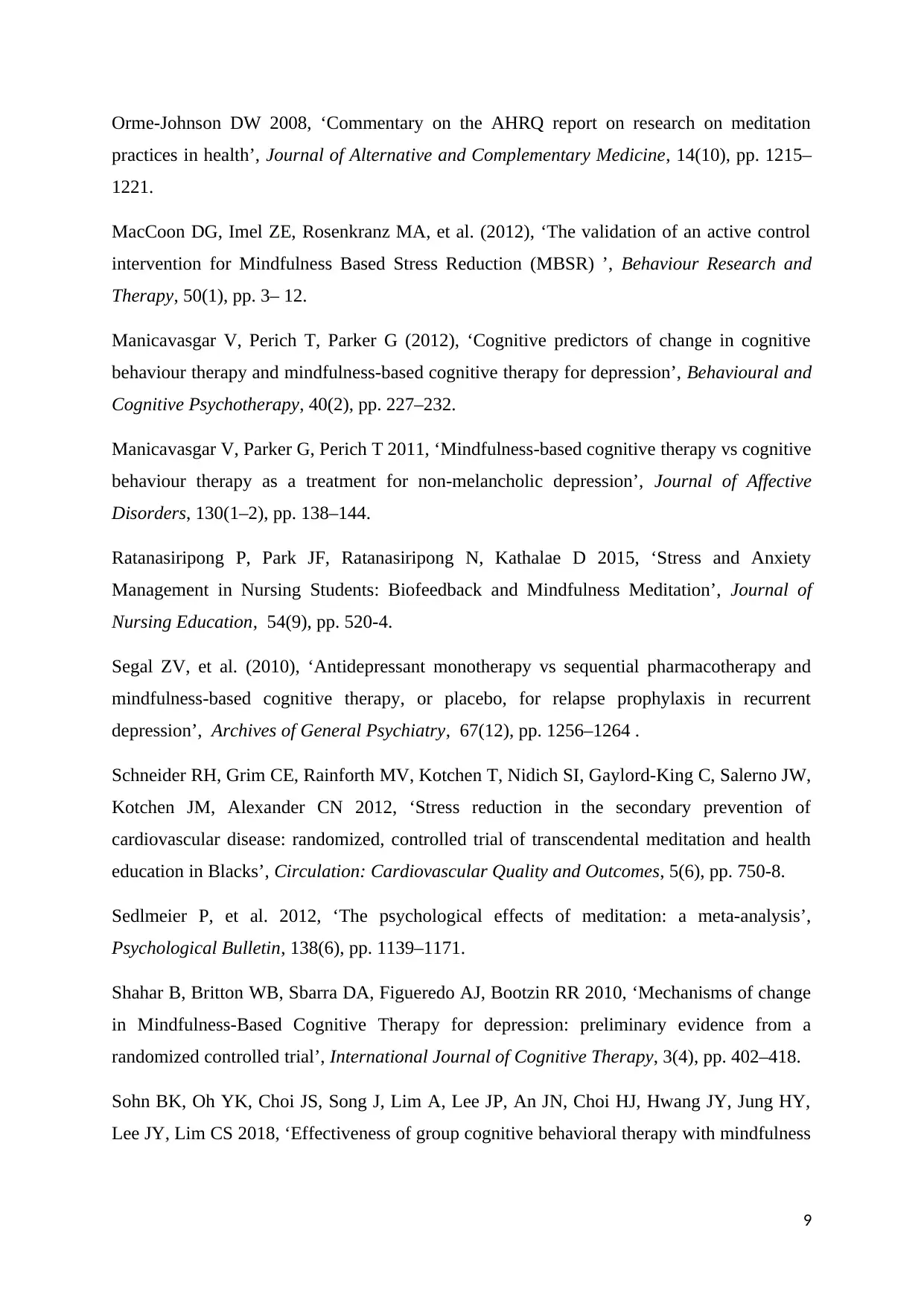
Orme-Johnson DW 2008, ‘Commentary on the AHRQ report on research on meditation
practices in health’, Journal of Alternative and Complementary Medicine, 14(10), pp. 1215–
1221.
MacCoon DG, Imel ZE, Rosenkranz MA, et al. (2012), ‘The validation of an active control
intervention for Mindfulness Based Stress Reduction (MBSR) ’, Behaviour Research and
Therapy, 50(1), pp. 3– 12.
Manicavasgar V, Perich T, Parker G (2012), ‘Cognitive predictors of change in cognitive
behaviour therapy and mindfulness-based cognitive therapy for depression’, Behavioural and
Cognitive Psychotherapy, 40(2), pp. 227–232.
Manicavasgar V, Parker G, Perich T 2011, ‘Mindfulness-based cognitive therapy vs cognitive
behaviour therapy as a treatment for non-melancholic depression’, Journal of Affective
Disorders, 130(1–2), pp. 138–144.
Ratanasiripong P, Park JF, Ratanasiripong N, Kathalae D 2015, ‘Stress and Anxiety
Management in Nursing Students: Biofeedback and Mindfulness Meditation’, Journal of
Nursing Education, 54(9), pp. 520-4.
Segal ZV, et al. (2010), ‘Antidepressant monotherapy vs sequential pharmacotherapy and
mindfulness-based cognitive therapy, or placebo, for relapse prophylaxis in recurrent
depression’, Archives of General Psychiatry, 67(12), pp. 1256–1264 .
Schneider RH, Grim CE, Rainforth MV, Kotchen T, Nidich SI, Gaylord-King C, Salerno JW,
Kotchen JM, Alexander CN 2012, ‘Stress reduction in the secondary prevention of
cardiovascular disease: randomized, controlled trial of transcendental meditation and health
education in Blacks’, Circulation: Cardiovascular Quality and Outcomes, 5(6), pp. 750-8.
Sedlmeier P, et al. 2012, ‘The psychological effects of meditation: a meta-analysis’,
Psychological Bulletin, 138(6), pp. 1139–1171.
Shahar B, Britton WB, Sbarra DA, Figueredo AJ, Bootzin RR 2010, ‘Mechanisms of change
in Mindfulness-Based Cognitive Therapy for depression: preliminary evidence from a
randomized controlled trial’, International Journal of Cognitive Therapy, 3(4), pp. 402–418.
Sohn BK, Oh YK, Choi JS, Song J, Lim A, Lee JP, An JN, Choi HJ, Hwang JY, Jung HY,
Lee JY, Lim CS 2018, ‘Effectiveness of group cognitive behavioral therapy with mindfulness
9
practices in health’, Journal of Alternative and Complementary Medicine, 14(10), pp. 1215–
1221.
MacCoon DG, Imel ZE, Rosenkranz MA, et al. (2012), ‘The validation of an active control
intervention for Mindfulness Based Stress Reduction (MBSR) ’, Behaviour Research and
Therapy, 50(1), pp. 3– 12.
Manicavasgar V, Perich T, Parker G (2012), ‘Cognitive predictors of change in cognitive
behaviour therapy and mindfulness-based cognitive therapy for depression’, Behavioural and
Cognitive Psychotherapy, 40(2), pp. 227–232.
Manicavasgar V, Parker G, Perich T 2011, ‘Mindfulness-based cognitive therapy vs cognitive
behaviour therapy as a treatment for non-melancholic depression’, Journal of Affective
Disorders, 130(1–2), pp. 138–144.
Ratanasiripong P, Park JF, Ratanasiripong N, Kathalae D 2015, ‘Stress and Anxiety
Management in Nursing Students: Biofeedback and Mindfulness Meditation’, Journal of
Nursing Education, 54(9), pp. 520-4.
Segal ZV, et al. (2010), ‘Antidepressant monotherapy vs sequential pharmacotherapy and
mindfulness-based cognitive therapy, or placebo, for relapse prophylaxis in recurrent
depression’, Archives of General Psychiatry, 67(12), pp. 1256–1264 .
Schneider RH, Grim CE, Rainforth MV, Kotchen T, Nidich SI, Gaylord-King C, Salerno JW,
Kotchen JM, Alexander CN 2012, ‘Stress reduction in the secondary prevention of
cardiovascular disease: randomized, controlled trial of transcendental meditation and health
education in Blacks’, Circulation: Cardiovascular Quality and Outcomes, 5(6), pp. 750-8.
Sedlmeier P, et al. 2012, ‘The psychological effects of meditation: a meta-analysis’,
Psychological Bulletin, 138(6), pp. 1139–1171.
Shahar B, Britton WB, Sbarra DA, Figueredo AJ, Bootzin RR 2010, ‘Mechanisms of change
in Mindfulness-Based Cognitive Therapy for depression: preliminary evidence from a
randomized controlled trial’, International Journal of Cognitive Therapy, 3(4), pp. 402–418.
Sohn BK, Oh YK, Choi JS, Song J, Lim A, Lee JP, An JN, Choi HJ, Hwang JY, Jung HY,
Lee JY, Lim CS 2018, ‘Effectiveness of group cognitive behavioral therapy with mindfulness
9
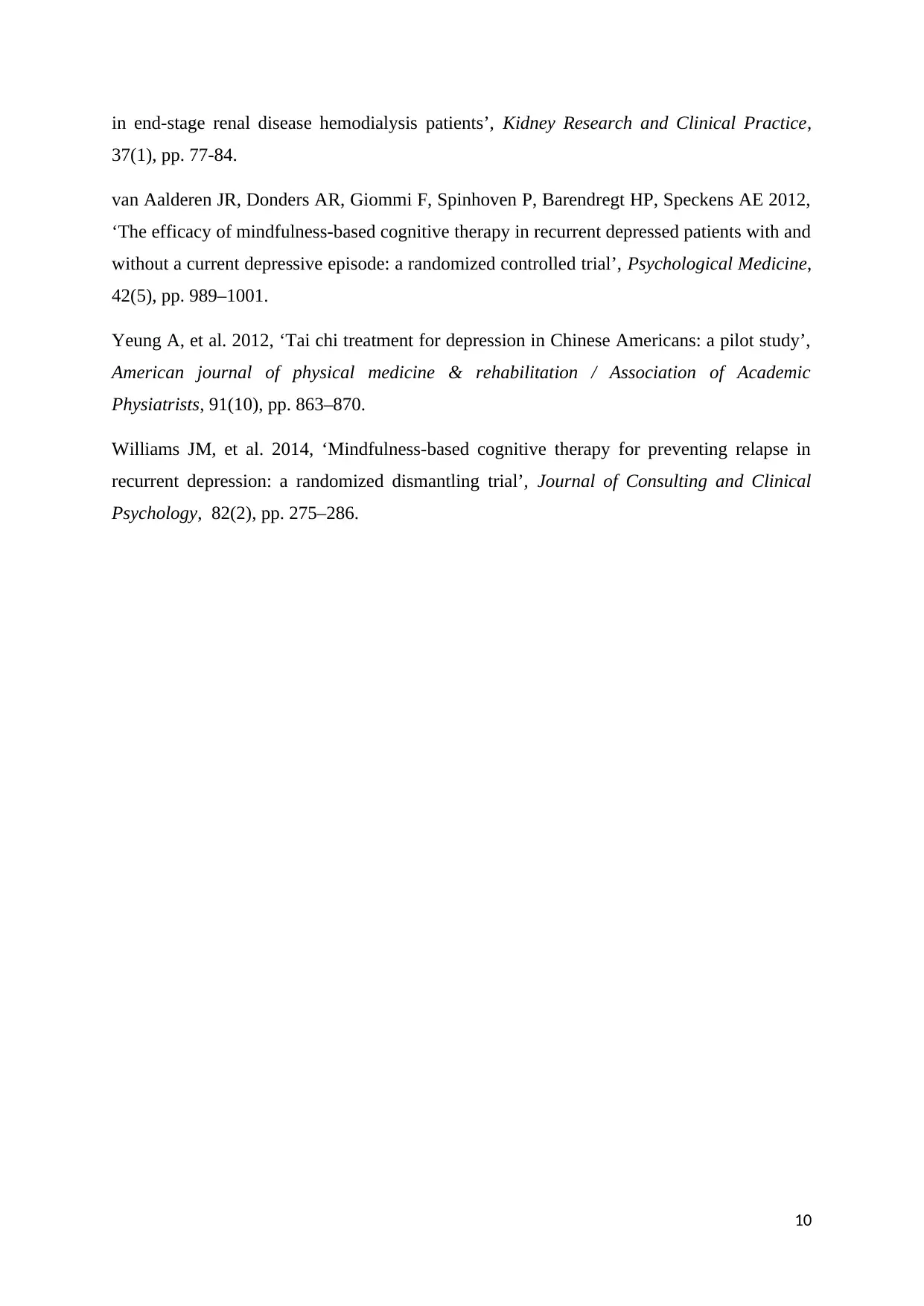
in end-stage renal disease hemodialysis patients’, Kidney Research and Clinical Practice,
37(1), pp. 77-84.
van Aalderen JR, Donders AR, Giommi F, Spinhoven P, Barendregt HP, Speckens AE 2012,
‘The efficacy of mindfulness-based cognitive therapy in recurrent depressed patients with and
without a current depressive episode: a randomized controlled trial’, Psychological Medicine,
42(5), pp. 989–1001.
Yeung A, et al. 2012, ‘Tai chi treatment for depression in Chinese Americans: a pilot study’,
American journal of physical medicine & rehabilitation / Association of Academic
Physiatrists, 91(10), pp. 863–870.
Williams JM, et al. 2014, ‘Mindfulness-based cognitive therapy for preventing relapse in
recurrent depression: a randomized dismantling trial’, Journal of Consulting and Clinical
Psychology, 82(2), pp. 275–286.
10
37(1), pp. 77-84.
van Aalderen JR, Donders AR, Giommi F, Spinhoven P, Barendregt HP, Speckens AE 2012,
‘The efficacy of mindfulness-based cognitive therapy in recurrent depressed patients with and
without a current depressive episode: a randomized controlled trial’, Psychological Medicine,
42(5), pp. 989–1001.
Yeung A, et al. 2012, ‘Tai chi treatment for depression in Chinese Americans: a pilot study’,
American journal of physical medicine & rehabilitation / Association of Academic
Physiatrists, 91(10), pp. 863–870.
Williams JM, et al. 2014, ‘Mindfulness-based cognitive therapy for preventing relapse in
recurrent depression: a randomized dismantling trial’, Journal of Consulting and Clinical
Psychology, 82(2), pp. 275–286.
10
1 out of 10
Related Documents
Your All-in-One AI-Powered Toolkit for Academic Success.
+13062052269
info@desklib.com
Available 24*7 on WhatsApp / Email
![[object Object]](/_next/static/media/star-bottom.7253800d.svg)
Unlock your academic potential
© 2024 | Zucol Services PVT LTD | All rights reserved.





